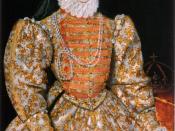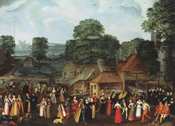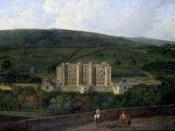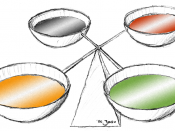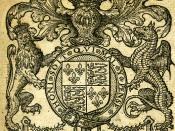Lungwort is Good for Your Lungs
During the reign of Henry VIII (1485-1509) in England, the royal confiscation of monastic land s and church properties put a huge crutch on the entire charitable system. Between 1536 and 1544, one would have to search far and wide for medical help, and there was absolutely no help for indigent people in the city of London. In 1569, royal hospitals were finally restored, including Christ's Hospital for Children, St. Mary's of Bethlem for mental cases, and general hospitals such as St. Bartholomew's and St. Thomas'. However, hospitals were not the only options for a sick individual. Queen Elizabeth I's reign (1558-1603) brought the restoration of general charity, and there were many types of professionals and individuals to turn to for seeking medicals attention. As a result of this broad spectrum of medical choices, a mixture of the theory of Humors, the Doctrine of Signatures, astrology, tradition, chemical science, and magic became the basis for popular medicine in Elizabethan England.
One of the most socially acceptable and encouraged forms of charity was medical charity. It was believed that sick people obviously needed help to have a positive recovery. Another motive for giving medical help was to help the poor make a safe return from sickness back to work, and thus removing the need to further provide monetary help. The city of Norwich often paid large amounts for physicians to treat the poor. It was also often that the city would hire one poor person to nurse and keep another poor, sick person, to kill two birds with one stone. An interesting fact is that it was common for a small sum to be paid initially to a bonesetter, but the bulk of the fee would only be paid when the patient was able to walk again. Thus, it is apparent that the practitioner took full responsibility for the patient during the recovery period. The city of Norwich also paid for shelter during the recovery period for patient. Norwich is the prime example of the great involvement and motivation for treating the poor and the sick in Elizabethan England.
When a merchant in Elizabethan London gets a fever, he first will ask the physician to diagnose him. Then, he will ask his wife if she knows of a certain herb that will lower his fever. If she has nothing in her stillroom, then she contacts an apothecary. The apothecary will then prepare the medicine prescribed by the physician. If finding little relief, the merchant will then go to the local "cunning" woman down the street, who will give him a charm sprinkled with bergamot oil, advise him to eat cool and dry foods, and maybe advise him to consider attaching a leach or two to his skin to relieve his blood Humor, This is an example of the common diagnosis and treatment of a patient.
It is apparent that medicine was distributed by an array of different people. The doctor a patient could see depended on the patient's class and whether he or she had the money to pay the fee. These professional physicians, who would have received an education at one of the Universities or Colleges for Physicians, were usually only afforded by the very wealthy. Surgeons had a similar reputation to the barbers, whom they associated with and belonged to in the Company of Barber-Surgeons. Barbers were only allowed to pull teeth or let blood by cutting or use of leaches. Usually, patients first visited the apothecary, who was the Elizabethan equivalent for today's pharmacist. They carried herbs, oils, chemicals, cosmetics, perfumes, and drugs. The Church could be considered a participating medical practitioner for providing attention and comfort to the sick and poor. Poor patients, however, usually first contacted the local "wise woman" or "cunning woman." Usually, this woman had a good reputation for traditional remedies and treatments. Bonesetters set bones for broken limbs and ribs. Midwives took care of the childbirth department of medicine. There were also herb-gatherers-and-compounders, hernia specialists, cataract couchers, dentists, and many other types other types of specialist. Lastly, there were ordinary Elizabethan housewives, who were expected to have some knowledge of simple herbal and traditional remedies to produce homemade medicines and potions. En masse, a patient who had many options, and picked and chose from different services from many individuals and types of providers.
Medicine in Elizabethan England was ridiculously basic for an era with terrible illnesses, such as the Bubonic plague and typhoid, and an enormous lack of sanitation in large cities with open sewers filled with garbage, infestation of rats, lice, and fleas, and no running water. The cause of illness was almost entirely unknown, and the beliefs were mostly based on teachings by ancient Greeks and astrology. The ignorance is also apparent in the common clothing of physicians, which were often seen as very strange. The clothing consisted of a large, full, dark cloak, boots, gloves, a hat, and a mask shaped like a bird's beak, which held bergamot oil. They also wore amulets of dried blood and ground-up toads at the waist for preventative purposes. It was also a custom to douse oneself with vinegar and to chew angelica before approaching the patient. These precautionary steps may seem very ridiculous and random. However, the popular belief about medicine formed from six different theories, which happened to make sense at the time.
The ancient Greek, Galen, formed the first theory. He believed that the body consists of our bodily fluids called "Humors": blood, phlegm, yellow bile, and black bile. Each humor possessed certain characteristics. Blood is hot and wet, Phlegm is cold and wet, Yellow Bile is hot and dry, and Black Bile is cold and dry. A natural balance of these fluids will keep the body in a healthy state. Any imbalance will result in illness. For example, a cold is the result of too much hot and dry phlegm in the body. This can be counteracted by drying and heating, or staying in bed and eating hot soup. For another example, a fever is the result of an excess of blood in the body. A treatment for the fever would be to remove excess blood with leaches, or eat cool and dry foods, like crackers. The characteristics of the four Humors were also considered for treating mental illnesses, as blood is sanguine, phlegm is phlegmatic, yellow bile is choleric, and black bile is melancholic.
The second theory is the Doctrine of Signatures. This theory comes from the Bible, stating that God gave Man lower creatures for Man to use for his benefit. Man uses many creatures for sustenance, and many creatures for labor. Other non-edible creatures on Earth should be used as ingredients in medicines. For example, Lungwort is good for the lungs, and Eyebright will clear the eyesight.
The third theory, astrology, has been signs and planet orbits of a patient's birthday to determine the severity and duration of an illness. The fourth theory is the traditional approach to medicine. This theory states that illness is a foreign presence in the body; the expropriation of the forging presence is the key to treatment. For example, an exorcism is necessary for mental illness, a King's touch is a cure for scrofula, tuberculosis in the neck, and toads are a cure for warts.
The fifth theory uses chemical science, in which newly discovered pure substances and non-organic materials were pressed into medical service, such as tobacco and mercury. The sixth theory deals with magic. In days, the dividing line between magic and legitimate medical practice was extremely blurred. Magic seemed perfectly logical and even scientific to an Elizabethan.
The most common cleansing agent used was vinegar, which was applied to most wounds to prevent from infection. The only cure for toothache was having the tooth pulled, which did not include the use of any anesthetics. Bubonic Plague was treated by applying warm butter, onion, and garlic to the bubo. Other various remedies for the plague were tried, including tobacco, arsenic, lily root, and dried toad. Head pains were treated with sweet-smelling herbs such as sage, bay leaf, rose, and lavender. Stomach pains were treated with wormwood, mint, and balm. Lung problems were treated with licorice and comfrey. These are all specific examples of treatments for common complication in the Elizabethan era.
An important benefit of all Elizabethan medicine is the confirmation of the placebo effect. The belief in one's treatment excites the patient's optimism and hopes, which is often the most important part of the recovery process. This is probably the most prevalent, underlying secret to Elizabethan medicine, whether the medical practitioners and patients knew it or not. The great variety of specialists, learned physicians, and magicians and all their ideas and beliefs, including the bodily Humors, the Doctrine of Signatures, astrology, tradition, chemical science, and magic, is important reason why everybody did not die in unsanitary, Bubonic Plagued, rat-infested, and garbage-filled Elizabethan England.
